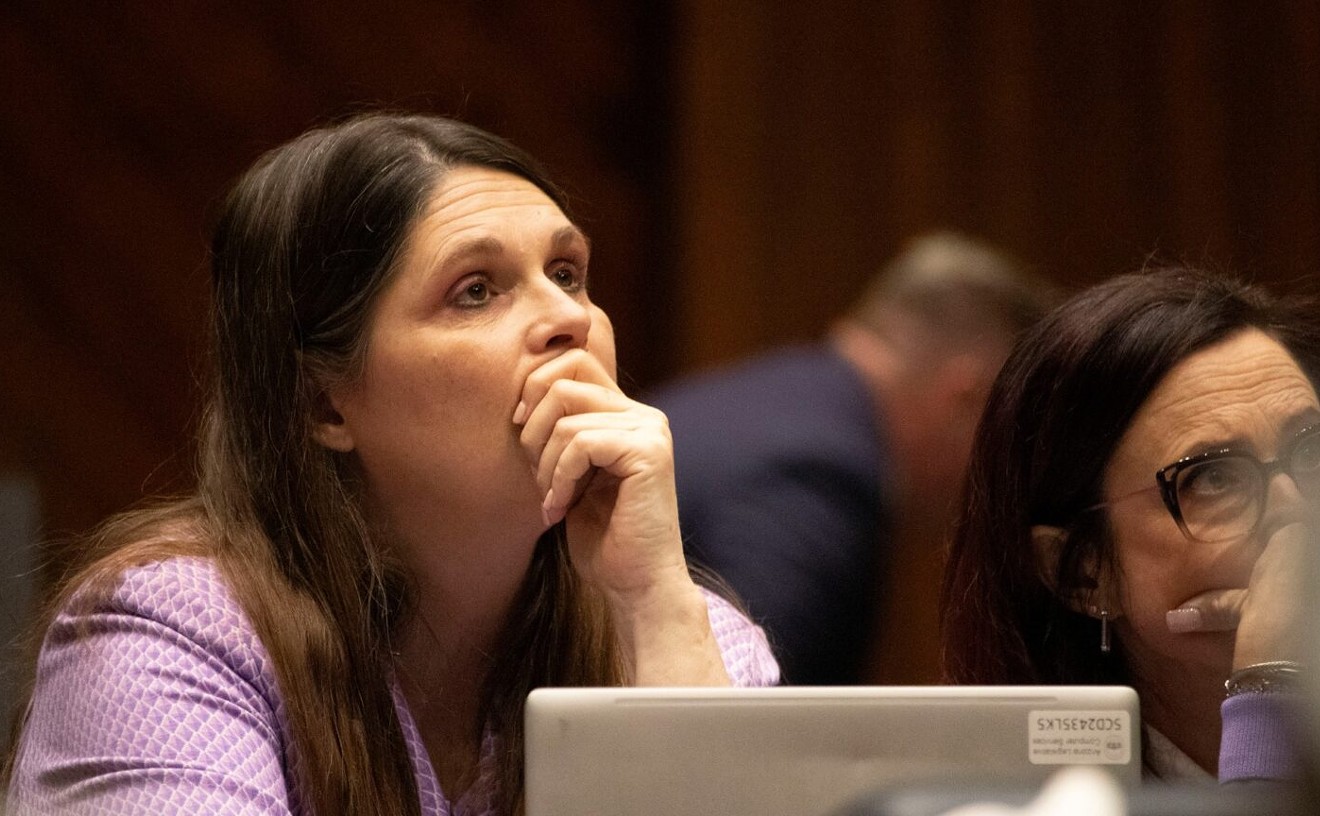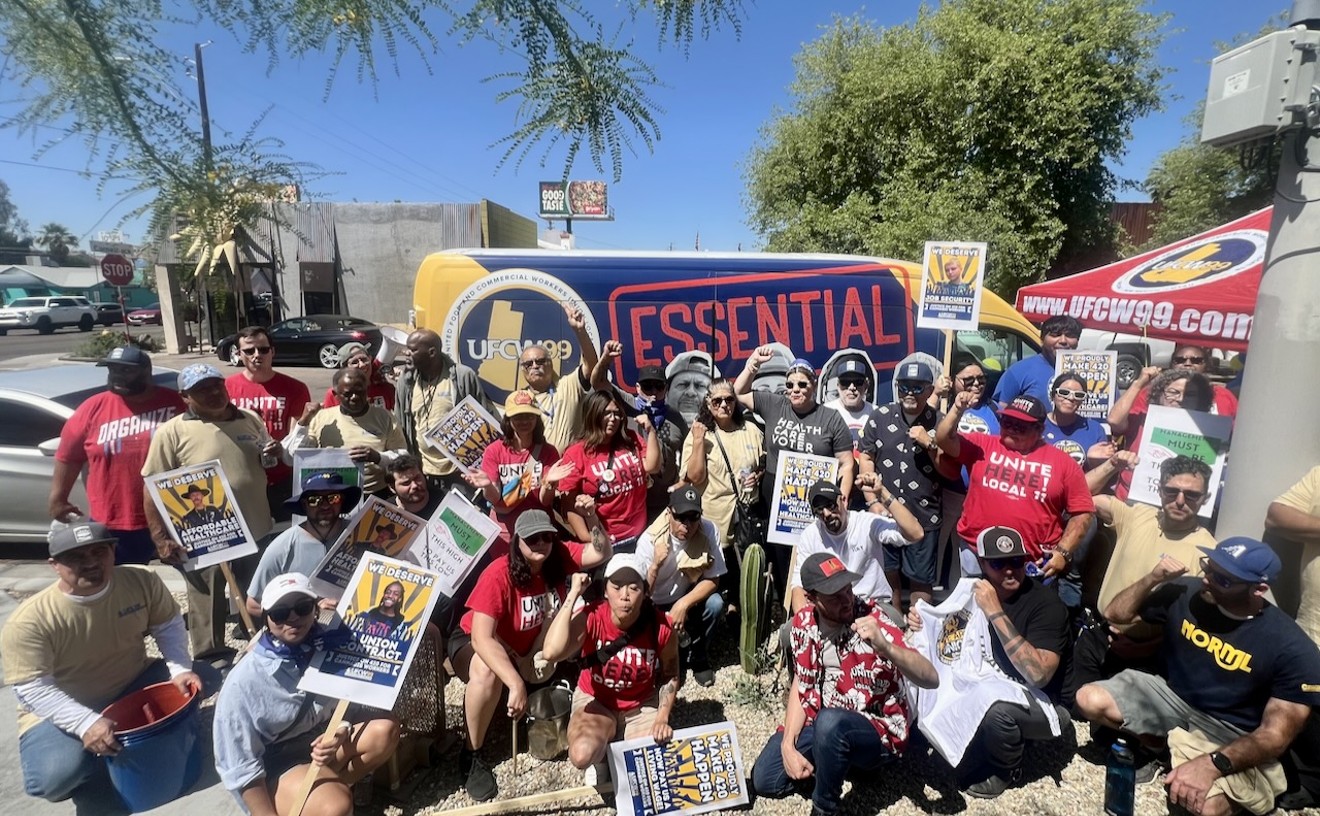Since 1980, the Maricopa County Sheriff’s Office reported to the FBI that county detectives were unable to solve 293 murders. In 16 cases, women between the ages of 20 and 40, including Anne Marie Levee, were shot to death or killed by unknown means between 1986 and 2014. Each of those cases went cold and stayed cold. Until February 2.
Donald Lee Scott once posed in military fatigues in the desert with a rifle, and then he wrote a line that prosecutors and ex-girlfriends might say defined the man.
“If you screw with me, I’ll screw with you, but twice as hard. And I WILL WIN.........,” Scott wrote on his Facebook page.
Except he never really did. The man who once wanted to be the law, fought the law. And the law won. Repeatedly.
Scott now stands accused in the shooting murder of 27-year-old Anne Marie Levee in the desert near the Pleasant Valley Airport in 1988.
The Maricopa County Sheriff’s Office arrested him early this month at the Glendale house the 55-year-old shares with an ex-wife and his mother.
In police interviews, Scott denied killing or assaulting Levee, according to court records filed by MCSO. But, those records noted, he couldn’t explain how his semen was found inside her vagina.
His case raises numerous questions. About Scott. About Levee. About how the case was pursued. About how MCSO keeps records. And about just how much we really know about murders.
In the years since Levee’s death, MCSO detectives solved about 55 percent of the homicide cases they got, according to data they report to the FBI. That’s slightly less than police nationwide.
But the success rate has slipped at MCSO to 44 percent since 2000, 13 percentage points below the national average.
That, and patterns in the types of cases that tend to go unsolved, convinced leading homicide expert Tom Hargrove that this region has more serial killers than we think and that it is one of the nation’s capitals of unsolved serial killings.
In the last year, Phoenix police have named two suspects they believe responsible for nine killings apiece. That brings to four the number of serial killing sprees in the last dozen years involving at least eight victims. Nobody is sure why.
No evidence exists that Levee’s death is linked to the other 15 like it during the same timeframe, bookended by Scott’s first and last arrests and during the times he was not in custody.
No available evidence suggests Scott preyed on other women or that he was involved these or other unsolved attacks.
But the sheriff’s office said in an email it “is looking into that possibility” that Scott might linked to other cases.
The investigation of Anne Marie Levee’s death started where it ended, with Donald Scott.
On December 10, 1988, Scott called 911 to report he’d found a dead woman in the desert north of town.
MCSO detectives showed up. Scott led them to Levee’s body. Detectives talked to him and someone they described as a “companion” and photographed their brown, four-door Chevrolet. Then, they let the pair leave.
Detectives returned to their grim task of collecting evidence from the crime scene.
There wasn’t much around. Nearby was an airstrip and trailer park. Just east down a stub of the Carefree Highway was the Wild Horse West bar and grill.
Everything else was flat desert. Nothing but gravel and sparse creosote shrub.
The woman had not been dead long. Her body was yielding clues. There were obvious fatal gunshot wounds.
Her pants were buttoned, but the zipper wasn’t all the way up.
Deputies took the body to the Maricopa County Medical Examiner’s Office. Pathologists found bruises and scratches on her inner thighs and around her genitals. They took samples for a rape kit and prints from the woman’s fingers.
They still didn’t know who she was.
Later, the Phoenix Police Department told MCSO detectives the fingerprints belonged to Levee.
It remains unclear how city cops knew that. There is no record of Levee in county or statewide court files or online state prison records. Nothing indicates she ever had run-ins with police.
The sheriff’s office told Phoenix New Times that Levee moved from Ohio, worked odd jobs, was going to school, and lived with her stepbrother. That’s about all we know. She was a ghost in life, as she became in death.

MCSO deputies found the body of Anne Marie Levee shot to death in the desert near here in 1988.
Sean Holstege
Scott had brown hair and a mustache. His brown car could be mistaken as maroon.
But the investigative trail went cold. MCSO offered no explanation, and available records don’t either.
And so it remains unclear if detectives suspected Scott or the companion. MCSO declined to discuss specifics.
“This guy should have been on the radar from the beginning as an investigative lead. So should this second person,” said Bill Richardson, a retired Mesa homicide detective who is critical of the way Valley police coordinate investigations.
“The information from that case should have been in the system,” Richardson said.
But there’s no suggestion it ever was.
The MCSO never asked the FBI for help profiling Scott or anyone else in the 1988 killing, a spokesperson told New Times, adding it has yet to log the case into a national database of violent crime arrests.
And no system exists within Maricopa County to track violent crimes from city to city.
“Especially in this time of public awareness of serial offenders, it doesn’t make sense,” Richardson said.
Also inexplicably, MCSO logged the crime in an FBI database as unsolved, weapon unknown, despite the obvious gunshot wounds.
And unsolved it remained.
Don Scott lived in tumult. In 1986, he was charged with endangerment. Police said he pointed a loaded .45 in the faces of his ex-girlfriend Shonna Clements and her pals as they emerged from a movie at Christown Mall. He slashed a couple of the tires on Clements’ car.
Scott told police he was in the wrong place at the wrong time and had nothing to do with it.
But he’d never been arrested, was the son of a retired Kansas City cop, and wanted to go into law enforcement himself. He needed only a few units to get his associate’s degree in the field.
“Since this incident occurred, it would be useless to go on with it,” Scott wrote a judge after changing his plea to guilty. The judge gave him three years’ probation.
That didn’t stick. Three months after sentencing, probation officers repeatedly found him with pistol, a rifle, and some ammo.
“Prior to his arrest, the defendant’s attitude was very combative,” a sentencing memo said. Angered, Scott took a Polaroid photo of the probation officer, refused to give it over, and lied about destroying it, the memo said.
Finally, after continued run-ins with probation officials, he was sent to prison in July 1989 and served eight months.
A psychologist who evaluated Scott found him to be of normal intelligence with no obvious signs of mental illness. But the psychologist saw some warning signs.
"He may always wear a Marine Corps fatigue cap as part of his dress. He appears to be attempting to present a macho military image,” the shrink said, noting Scott was controlling, defensive, and rigid, seeing the world in black-or-white terms.
That’s how Scott reacted when the evaluator recommended, and the court ordered, short-term counseling. He wrote a judge telling him he didn’t need it, that it was waste of time and money, and that “I feel like I’m being pushed and harassed.” He told the ACLU and his congressman, too.
Ten years later, in 1999, Scott returned to prison. This time, he was found guilty of harassing his ex-girlfriend Deborah Charlesworth.
She told police he’d throw rocks through her window, smash her car window, and pull up the flowers in her front yard. Charlesworth’s mother said he slashed the tires of her car and called repeatedly.
Once again, Scott deflected. He blamed his accusers of harassing him.
Police said he had sent Charlesworth a suicide letter and said his death was all her fault. When police came to the Phoenix house to arrest Scott, his father said he’d tried to OD on prescription pills.
Evaluators remained fairly sympathetic. Scott, now 36 and divorced, lived at home and took care of a younger brother who was severely disabled, according to court documents. The family described Scott as a devoted father of three girls, then between 4 and 10 years of age. He reported a happy childhood. He held down jobs, as a satellite dish installer and now a framer. He had never failed a drug test and had no history of excessive drinking.
Clinical evaluations and personality test results, one doctor advised the court, “do not lead me to fear for society’s or the victim’s safety.” He later added, “He is a low risk for imminent violent behavior.”
But again, the psychologist noted red flags. Scott’s demeanor was remarkably obsessive/compulsive, he wrote. Scott was defensive, inflexible, and lacking insight.
He had “stereotypical views of women. He possibly harbors hostile and aggressive impulses,” the psychologist wrote.
A pre-sentencing memo recounted a string of violent confrontations with people close to Charlesworth, including one in which Scott chased a man with a baseball bat and another in which that man pulled a knife on him. Scott just laughed.
He suggested to authorities that people close to Charlesworth were setting to trap him in a probation violation.
In a handwritten court motion, Scott begged for leniency so that he could “return to work and support my family and help my parents in time of need.” His father had had strokes and the house needed repairs, he wrote.
He apologized to the court.
“I find myself to be a caring and thoughtful person,” he wrote. “I try so hard to make things work that I don’t realize that I may be hurting someone’s feelings.”
His mother, Rosalie Scott, naturally took the side of her “all-American country boy.”
“He was the type of person who really tried his hardest at everything, even when the odds were against him,” she wrote the court, explaining how he tried to get into the military and law enforcement, despite his poor eyesight.
“Don tries hard to make others happy, too hard at times. He’s blind in that he doesn’t see that by helping others he sometimes hurts himself,” she wrote. “In this case he tried so hard to make things work, but he didn’t realize it actually made things worse.”
Scott went back to prison for five months.

Donald Lee Scott reported finding Anne Marie Levee's body after driving around in the desert near an old spur of Carefree Highway.
Sean Holstege
In 2013, prosecutors charged Scott with felony aggravated harassment. They said that in December 2012, he’d violated a protection order the court had granted his ex-girlfriend, Victoria Lee Orlando.
According to court records in the case, the couple started dating around 2000, but had split up around 2008. In October 2012, Scott called her eight times in one day, and another time he showed up at a bank ATM at 5 a.m. to talk to her.
Orlando told police, court records stated, she was afraid of him because he’d assaulted her twice and owned “numerous firearms.” Scott had a 9 mm pistol when police arrested him in Scottsdale.
Police found a GPS device on Orlando’s car.
Scott now lived in New River. He told the intake officer in jail he’d never served in the military.
In 2004 he had posed for that photo in the desert with fatigues and a military-style rifle. He posted it on Facebook in 2011 in support of the troops. The only movies and TV shows he listed were about combat, with titles such as Saving Private Ryan, Full Metal Jacket, and The Rat Patrol.
That’s all there was to his Facebook page.
Scott pled guilty to the stalking charge, in return for dropping the assault charge.
In 2014, Scott was back in court, again facing charges of stalking and felony harassment.
This time, Denise Lea Anderson, another ex-girlfriend, had a protection order against Scott and told prosecutors he’d inflicted what they described as “significant emotional harm.”
Once again, police said in court records, he put a GPS on her car. He’d park across the street from her apartment and texted her every time she went on the balcony to smoke. He had never been to the apartment and watched her with binoculars.
On October 20, 2014, police had Anderson call Scott. During that call, he threatened to kill himself.
The next day police went to arrest him at a hotel near Interstate 17 in north Phoenix. He made a run for it, but cops nabbed him.
He told authorities he was transient, bouncing from hotel to hotel as a self-employed builder, and that he’d never been in the military.
According to court documents, he admitted to buying a GPS but not putting it on Anderson’s car. Instead, he blamed her for putting a GPS on his car. He said he never meant any harm.
County prosecutors combined the two cases. A woman named Dina Lancaster emerged as a witness for the prosecution. She had dated Scott after Victoria Orlando and before Denise Anderson said he’d stalked them.
Lancaster told a similar story in depositions with Scott’s attorney and in police interviews.
They met in December 2012 in an online dating service called hookup.com. They dated a month.
At one point, Scott showed Lancaster a GPS tracking system on his laptop. He told her that he was part of “Force Recon,” a special unit of the Marines and he was tracking an Al Qaeda target.
Another time, Scott and Lancaster were on a date in Scottsdale Fashion Square. Scott saw a man in Marine uniform, said hello, and then reported him to mall security as an imposter. Lancaster’s son had served in the Marine Corps and told her the man looked legit and the boyfriend was acting weird.
Then Lancaster found out Scott had a prison record.
After that, she said, “I got scared. Because he always talked about guns. And he always talked about police were stupid. And I just felt very, very vulnerable.”
The court took a dimmer view of him this time, especially after he failed to show up. The judge issued a bench warrant and cops hauled him back in.
Prosecutors wrote, “The State believes it is imperative to ensure the defendant is monitored in the community for the rest of his life to ensure the safety of other women.”
He got 20 years’ probation and 18 months in prison.

Maricopa County Sheriff's Office deputies responded to a report of a dead woman in 1988 on this stretch of Carefree Highway.
Sean Holstege
Maricopa County sheriff’s detectives didn’t know it in 2014, but locking Scott up on the harassment charge would later become a major breakthrough in their cold whodunit case in the death of Anne Marie Levee.
Eleven years earlier, in 2003, for reasons still not fully explained, MCSO reopened the case and resubmitted to the state lab a semen sample taken from Levee’s body.
Technicians at the Arizona Department of Public Safety Crime Lab analyzed the sample and submitted the results to CODIS, the Combined DNA Index System. CODIS, a national database of DNA samples, helps detectives crosscheck forensic evidence against known criminals and suspects.
There in CODIS the sample sat, awaiting a match.
Detectives did not know whom the DNA belonged to, nor the type of man he was.
But police, who’d locked him up for his string of harassment charges, were crystal clear. On the jail intake form in 2014, they listed prior arrests: kidnapping, sexual assault, felony aggravated assault, plus all the others he’d been convicted of.
Then the match was made. In December 2016, the results were in. The DNA from Levee’s body belonged to Scott. Now, detectives had a suspect. They got another sample from Scott to confirm the match.
The sheriff’s cold-case detectives worked with the Maricopa County Attorney’s Office Cold Case Unit and the Maricopa County Probation Department to track down Scott and other people connected to the original case.?
Then, in January of this year, the lab confirmed Scott’s fresh DNA sample matched that the two samples technicians had run.
On February 2, deputies arrested Scott at the Glendale house where his mother and his ex-wife Dawn Scott lived. Neither woman returned calls from New Times.
Now sheriff’s detectives knew what police had known. On the intake form they wrote that Scott was too dangerous to release because he is “a serial offender of stalking and harassing.” Plus, now he faced murder charges.
By now, Scott might have been unsure of who he was himself. Or he was living a fantasy or a lie. Now, he told jailers he had served in the Army, National Guard, and Marine Corps.
In the 2013 case, police detectives had already contacted the military and learned that Scott had never served.
The Marine Corps rejected him because of poor eyesight, but did enlist his older brother, William.
Donald Scott had tried to use his fake military service to con the judge into a lighter sentence, prosecutors at the time said, calling it “an outrageous lie and disservice to those who actually served in the military.”
He proffered a string of lies, court documents noted.
Scott had falsely accused Orlando of shooting at him to create an alibi, and he’d gotten his mother to lie in letters to the judge about his military record, they said.
He offered to pay one of his daughters $200 to make a false rape allegation, she wrote in blistering letter before he went back to prison, according to court documents.“To me, you are just a sperm donor. You have had years to be a real parent yet chose not to."
tweet this
By now, Scott’s act fooled nobody, least of all his daughter.
“To me, you are just a sperm donor. You have had years to be a real parent yet chose not to,” she wrote.
“You are a deadbeat. You are a piece of shit. You’re stuck in your own fantasy land and think you’re going to get away, but you won’t,” she continued, shredding him for thinking he could become a Marine. “Give it up and man your ass up and quit pretending.”
She tore into him about the guns, too.
“I guess buying guns for your (pleasure) is more important than taking care of us,” she wrote.
After calling him a cheater and someone who thinks he can control everyone, she penned, “You’re just worthless. Not married, no house of your own, no real job, and losing all your kids. Yeah, have fun when you’re old.”
“Bye. Have fun in jail.”
Donald Lee Scott only spent eight days in state prison. He had already served almost his entire 18-month sentence awaiting trial. He re-emerged from confinement in March 2016.
But his conviction carried a different, potentially grave, price. He had to submit a DNA sample, and that sample worked its way through crime labs and a national database back to a woman’s body in the desert in 1988, police now say.
Now, in February 2018, he was back in jail again, this time facing murder charges.
He told detectives that he never had any contact with Levee, never had sex with her, never even knew her, according to court records. He said he didn’t get close enough to her body to even see her wounds.
Detectives asked him why his semen was found inside her. He couldn’t explain.
Detectives reinterviewed the shadowy “companion.” He or she — we still haven’t been told which — told police the pair were driving around the desert for several hours before they found the body. The companion couldn’t recall if Levee had wounds on her face or chest.
The sheriff’s office wouldn’t say what role that person may have played in the case.

Donald Lee Scott after he was arrested and charged with the murder of Anne Marie Levee.
Maricopa County Sheriff's Office
For them, his biography checks many of telltale boxes of a serial predator. Many serial killers take their hatred to new depths after serially raping women doesn’t satisfy their urges. It’s not uncommon, criminal profilers, detectives, and criminologists say, for murder to become an act of sexual gratification for some killers. Often, a sense of sexual inadequacy or dysfunction goads them.
A stereotypical FBI profile of a serial killer is a white, male loner in his 20s to 40s, often living with his mother, often unsuccessful in life, love, or both.
Mike Aamodt, a researcher at Radford University in Virginia, has spent a quarter-century studying serial killers and has amassed a meticulous database of 4,800 of those we know about.
He found that the FBI profile only matches one in eight.
But it matches Donald Scott well.
“If you look at his behavior, he’s a violent criminal. He targets women. He probably has other victims,” Richardson, the retired homicide detective, said.
MCSO provided no evidence to suggest he’s right.
But with no central repository in the state, detectives are hamstrung, as they were in 1988, in their efforts to check. If they checked.
The problem is made worse by spotty or inconsistent record-keeping.
From 1994 onward, MCSO detectives investigated 36 cases of women of the same age range who were shot to death, as Levee had been. Detectives solved 24 of them, they reported to the FBI.
The Maricopa County Medical Examiner’s Officer keeps a database of every autopsy in which pathologists declared the manner of death to be homicide and reported to the Centers for Disease Control. The data goes back to 1994.
The data, obtained by a New Times public records request, shows county pathologists only logged 22 homicides that it referred to MCSO.
The county had 14 more criminal cases than bodies in the morgue. It remains unclear how.
That’s not the typical pattern.
Normally medical examiners report more homicides to the Centers for Disease Control than detectives report to the FBI. In a recent study, the Washington, D.C., based nonprofit, The Murder Accountability Project, reported there are at least 29,800 such “missing murders.”
In 2015 alone, authorities in Arizona reported 60 more homicides to the CDC than FBI.
Of the 22 cases Maricopa County pathologists processed for the sheriff’s office, only 12 matched the FBI’s murder database. A third of those had discrepancies in the filing dates.
That means that at best, 10 cases — almost half — were never reported to the FBI.
There may be more murders than we know about.
In an effort to catalog every murder, New Times requested MCSO provide a list of all cold-case murders since 1980. The sheriff’s office provided a three-page document.
It listed 53 cases from 2007 onward, leaving 23 known cases missing during that time. MCSO declined to mention 240 cases from 1980 onward.
In the cases MCSO did list, the response left vague the causes and locations of many murders.“How ballsy is it to murder somebody and then report the body?"
tweet this
Poor reporting of unsolved crimes has been a pattern at MCSO, Richardson said, pointing to a study by the libertarian-leaning Goldwater Institute in 2008.
Goldwater criticized the MCSO for “poor record-keeping and reporting of statistics, coupled with resistance to public disclosure.”
It reported that the sheriff’s office didn’t know detectives’ caseloads or the status of those cases, and that official statistics were deemed unreliable.
So with no shared information among other Valley agencies, nothing logged into federal databases and even its own records unreliable, it’s little wonder to Richardson the investigation of Donald Lee Scott fizzled out.
“If police were looking for somebody who was a serial stalker, how would they find him?” Richardson said.
Scott was proven in court to be a serial stalker. A series of women, starting in 1986 and continuing to 2014, said his temper and his fixation on guns and surveillance gear scared them. They got restraining orders to keep him away and he scoffed.
He tried to control them. When they refused, he tried to control the courts, planting letters puffing up his community good works and cajoling judges into thinking counseling was a waste of resources. He tried, prosecutors now hint, to control the police he had wanted to join but now thought were stupid.
“How ballsy is it to murder somebody and then report the body? He’s controlling the life of the woman he murdered and he’s also controlling the MCSO,” Richardson said.
Certainly Scott was bold enough to fool some people. In 1986, Wyandotte County (Kansas) Deputy Chuck Morris, who had worked with both him at a local community college and his dad, wrote:
“I have never known Don to cause any trouble or break any laws. In fact, he is one of the most law enforcement oriented person (sic) that I have ever known. I do not hesitate to give him the highest character reference possible to give any human being. If I had anything negative to say about Don, it would be that he is over dedicated (in underlines). He sometimes leaps into a situation where a more experienced officer would back off.”
But Scott couldn’t control fate. Fate gave him that bad eye that crushed his dreams of a life in uniform. And fate gave him a personality that made him seem delusional, blind as his mother had said, and impulsive.
Indeed, he once wrote to a judge, “At times I let my heart take control, instead of my brain.”















